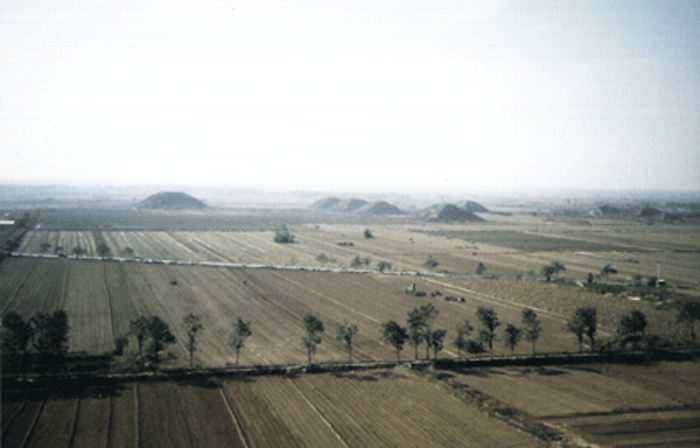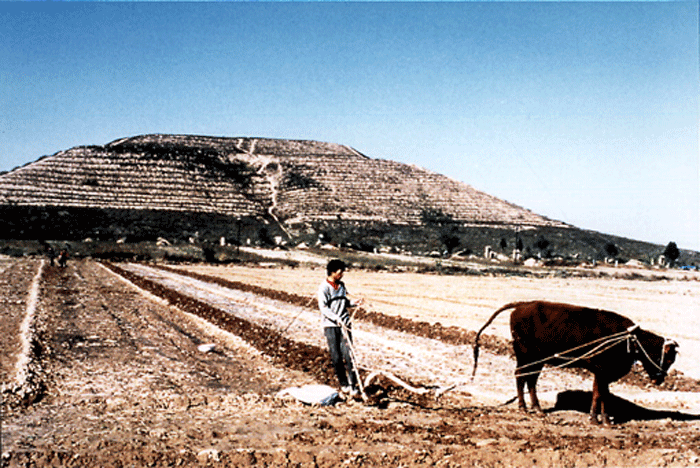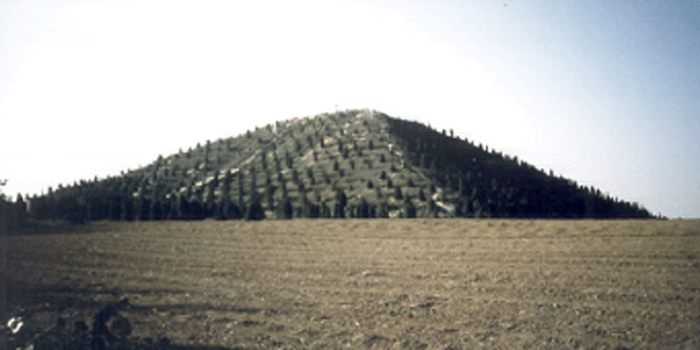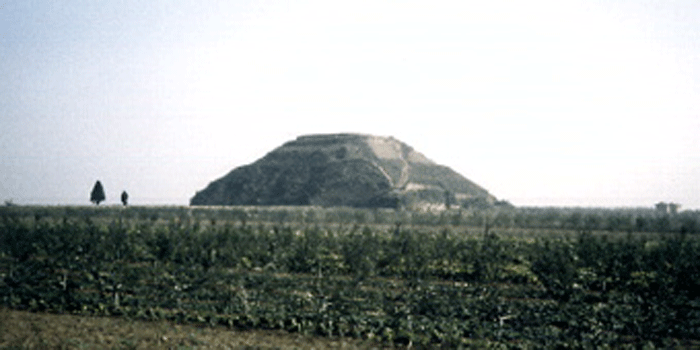|
내몽골 에서 찾은 5000년 된 피라미드
(번역본)
중국 고고학자들은 중국북부 내몽골 자치 지역에서
무려 5000년 이상된 피라미드로 보이는 건축물을 발견했다.
그 피라미드는 Aohan Banner 지역의
Sijiazi 마을에서 북쪽으로 1킬로 떨어진 산등성이에 있었으며 아래부분 길이는 30미터이상 폭은 15미터 이상인 3층 석조
건물이다.
요녕(요동 요서) 고고학 연구센터의 유명한 중국 고고학자인 '구오다쉰'에 의하면 이 피라미드는
지금으로부터 5000년 내지 6000년 전인 “홍산 문화” 때의 것이다.
일곱개의 무덤과 제단의 유적들이 피라미드 꼭대기에서
발견되었다. 제사단이 있던 자리에서는 한문 쌀 미자(米) 그림이 새겨진 도자기 조각이 발견되었다.
고고학자들은
쌀 미자(米) 그림은 고대의 그 사람들이 천문天文을 익히기 위한 무엇이었을 것이라 말했다.
한 무덤에서
고고학자들은 뼈로 만든 피리와 돌 반지를 찾았고 다른 무덤에서는 사람의 크기만한 여신女神 조각이 새겨진 돌을
발굴했다. 고고학자들은 무덤의 벽에 새겨진 힌두교 시바신의 상징을 찾고 놀랐으며 벽에 새겨진 힌두교 시바신의
상징 밑에 여신女神들이 있는 작은 돌 조각상을 찾았다.
'구오'라는 고고학자는 상당수의 유물들이 처음 발굴되는 것들이며
이것들은 홍산 문화의 매장 풍습과 종교, 산제물을 바치는 의식, 그리고 사회 구조에 대한 연구를 하기 위한 대단히
중요한 유물들이라 말하였다.
그가 또 지적하는 바로는, 피라미드의 발견은 중국 문명의 근원을 밝혀나가는데 대단히 중요하다고
말하였다.
홍산문화는
내몽골 (중국의 내몽골 자치주),
요녕 (만주 서부),
하북 (요녕 서쪽) 에 걸쳐서 분포된 신석기 문화권에 속한다.
(신화통신 2001-7-9)




(영문원본)
5,000-year-old "Pyramid" Found
in Inner Mongolia
Chinese archaeologists has discovered a pyramid-shaped
building, dating back more than 5,000 years ago, in the Inner Mongolia
Autonomous Region, in north China.
The "pyramid", located on a
mountain ridge one kilometer north of Sijiazi Township in the Aohan Banner
(county), is a three-storied stone building, with the bottom layer being more
than 30 meters long and 15 meters wide.
The "pyramid" belongs to the
Hongshan Culture period of 5,000 to 6,000 years ago, according to Guo Dashun, a
famous Chinese archaeologist who works in Liaoning Archaeological Research
Institute.
Seven tombs and ruins of an altar were found on the top
of the "pyramid." At the site of the altar there are many fragments of broken
pottery carved with the Chinese character “mi" (rice). Archaeologists said that
the character "mi" may have something to do with people's understanding of
astrology in ancient times.
In one of the tombs, archaeologists
found a bone flute and a stone ring, and they unearthed a stone sculpture of a
goddess the size of a human body in another tomb.
Archaeologists
were surprised to find a stone-carved linga on the wall of a tomb and a small
stone statue of a goddess below the linga in the same tomb.
Archaeologist Guo said that many of the relics were first-time
discoveries and they are of great significance in studying the burial customs,
religious and sacrifice rituals, and the social structure of the Hongshan
Culture.
He pointed out, the discovery of the "pyramid" is also of
great significance in exploring the origin of the Chinese civilization.
The Hongshan Culture, belonging to the Neolithic culture, is mainly
distributed in the juncture area between Inner Mongolia, Liaoning and Hebei
provinces.
(Xinhua News Agency 07/09/2001)
http://www.china.org.cn/english/15802.htm
--------------------------------------------------------------------------------------------------------
중국 북부지방에 대형 피라미드 1백여개
지금까지 중국 대륙에는 이집트, 남미에
있는 대형 피라미드가 존재하지 않는 것으로 알려져 왔다. 그러나 최근 해외정보에 의하면 중국북부(만주, 내몽고)에는 크고
작은 피라미드가 분포되어 있는 것으로 확인되었다.
이들 피라미드는 외형적으로 확인할 수 있는 것이 있고
수천년 세월이 지나는
동안 수목이 우거진 산처럼 변해 있는 것도 많다. 지역농민들은 처음에는 평범한 산으로 생각했다고 한다.
그런데 중국
당국은 이들 피라미드 연구 탐사를 철저하게 금지하고 있다.
높이는 낮으면 수 십미터, 높은 것은 1백미터나 되는 것도
있다. 한국 재야학자들은 이 피라미드가 배달국 시대의 천단이나 왕과 고위층의 무덤으로 추정하고 있다. 보통 축조연대는
배달국과 고조선 시대로 사료된다.
(홍익세계 편집부)
|